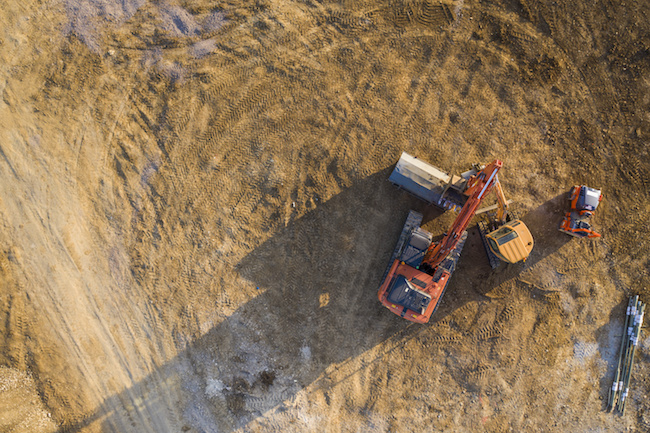

Proactive steps are needed to keep hydraulic oil clean and machines running. PHOTO: Adobe Stock/Ink drop
The presence of contamination in hydraulic fluid can cause system failure, meaning that an appropriate level of oil cleanliness is required to maintain a reliable hydraulic system. The cleaner the oil, the longer excavators, wheel loaders and other equipment will operate reliably. To realize the full lifecycle of the oil and mitigate the risk of system failure, operators should take proactive and predictive steps to ensure oil cleanliness.
OIL CLEANLINESS EXPLAINED
The extent of an oil’s cleanliness refers to the degree of particle contamination present, including both insoluble and hard particles, which are often not detectable by the naked eye. Contaminant particles can inhibit the fluids’ ability to lubricate parts with tight clearances, causing increased wear on system components when present within an oil. This is especially critical in hydraulic systems where tight clearances and increased operating pressure renders the system more susceptible to particle damage.
Contamination is most likely to be introduced into a previously clean system via external contamination, through hydraulics seals, inadequate air breathers or during sampling, oil addition, filter changes, storage, handling and dispensing. Internal contamination occurs as a result of mechanical wear inside the system and as a result of oil degradation. While oil contamination cannot be completely eradicated, it can be controlled with proper filtration and maintenance practices, which enable a system to run reliably. Acceptable cleanliness levels will vary depending on the type of system and are often established by OEMs.
MAINTAINING OIL CLEANLINESS
Oil cleanliness and its effect on the overall reliability of the hydraulic systems cannot be overlooked. Simple maintenance principles can help keep hydraulic systems protected against contamination and maintain an acceptable level of oil cleanliness:
- Filtration — To protect the hydraulic fluid from exposure to internal and external contaminants, using filters of the correct micron rating and beta ratio (filter efficiency) will allow contaminants to be removed faster than they are generated or introduced. This constitutes an effective filtration system which will ensure the oil contains very low levels of impurities. Combined with checks on oil filter condition (pressure differential) this will extend the working life of the oil and components in the system, avoiding the costly process of frequent lubricant changes due to contamination and associated downtime.
Filtering all oil stored in a facility by using kidney loop filtration on all bulk storage tanks, as well as establishing proactive and reactive filtering measures is recommended as a best practice. Filtration devices, such as portable filter carts or stationary filtration installations should be used on a proactive basis to remove particles from a machine’s hydraulic oil and on a reactive basis when oil sampling indicates ISO particle counts have risen above target levels.
- Storage, handling and dispensing — Lubricants become susceptible to contamination during storage, handling and during any transfer process – whether pumping from bulk dispensing or individual drums. When dispensing from bulk or drums, desiccant-type air breathers or at least sintered bronze bung filters, should be ideally used.
Unfortunately, it is also common for lubricants to become contaminated from dispensing equipment that has not been properly flushed, cleaned or is unsuitable for the use. Oil should, therefore, be filtered as it is transferred into sealed, airtight containers. Dedicated transfer pumps and/or filtration equipment should also be used for each product type.
- Used oil analysis (UOA) — Today’s hydraulic systems are smaller and more powerful than ever. Couple this with the need to remove very small particles (less than six microns), cleanliness monitoring through a used oil analysis program is vital in detecting contamination.
Monitoring the levels of key properties within the hydraulic oil enables owners and operators to predict issues and schedule maintenance before issues become too expensive or serious to repair. This effectively helps to reduce the risk of unplanned downtime and sudden failures.
Prompt corrective action is required on oil analysis results to prevent more serious mechanical issues. Resourceful reliability and maintenance teams are increasingly taking advantage of digital diagnostic tools — Petro-Canada Lubricants’ LUBE 360 Oil Diagnostics, for instance — to support equipment and maintenance managers to do this. Digital tools make sampling and the review of oil analysis data accessible on tablets and mobile devices which give operators immediate and instant insight. Customizable dashboard graphics help asset managers prioritize results and detect abnormalities to recognize contamination sooner, which means steps like filtration can be taken to maintain oil cleanliness. Utilizing oil diagnostics effectively keeps an operation one step ahead, allowing you to proactively track the need for maintenance and predict where it will be needed in the future.
Preserving oil cleanliness is all about reducing the risk of contamination, both internally and externally. Ensuring an acceptable level of contamination starts with implementing a system that encourages a clean working environment to reduce exposure to potentially harmful impurities. Additional processes like filtration and used oil analysis should also be complimented by correct storage and handling practices. Despite the fact that contamination can never be truly eliminated, maintaining an acceptable level of oil cleanliness is vital to ensuring the reliability of a hydraulic system and safeguarding the execution of the construction operation upon which it is dependent on.
Neil Buchanan is a senior technical service advisor at Petro-Canada Lubricants, a HollyFrontier brand. Based in Minneapolis, Minn., he is a registered professional engineer and Certified Maintenance and Reliability Professional (CMRP). He is also Certified Lubrication Specialist and OMA I and OMA II (Oil Monitoring Analyst) certified with the Society of Tribologists and Lubrication Engineers.




